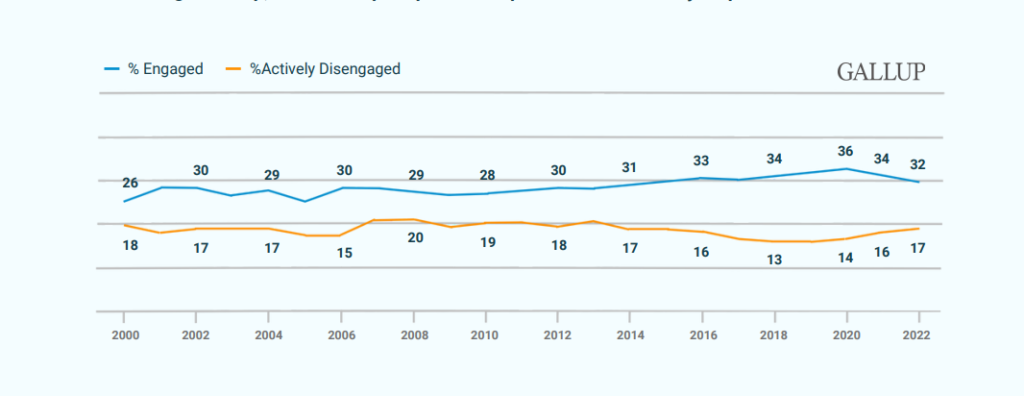The Engagement Problem and the Happiness Solution

Employee engagement has been a buzzword in organizational development for over three decades. Despite millions of surveys, extensive research, and substantial investments in software and consultancy, engagement scores have remained stagnant. According to Gallup, the issue isn’t just a post-pandemic phenomenon but a persistent problem spanning over 20 years. This raises a critical question: why haven’t engagement strategies worked, and what can be done to turn the tide?
The Stagnation of Employee Engagement
Engagement surveys from various organizations like Gallup, Qualtrics, Glint, and CultureAmp consistently show that engagement scores have barely budged. The statistics paint a bleak picture:
- Recruitment has become more challenging, with the average hiring process extending to 44 days, the longest in decades.
- Productivity has plateaued since 2007, following a steady increase from 1973 to 2006.
- Turnover rates have risen by 10% since 2000, with 2023 seeing rates of 17.3% for salaried employees and 49% for hourly employees.
Clearly, traditional approaches to measuring and improving engagement aren’t delivering the desired outcomes.
The Root of the Problem: Misunderstanding Engagement
The concept of employee engagement has been inconsistently defined and applied. Scholars like Alan M. Saks and Jamie A. Gruman highlight that there is no universally accepted theory of engagement. The prevalent job demands and resources (JD-R) model suggests that the more resources employees have, the more engaged they will be. However, this model doesn’t fully capture the complexity of engagement.
Additionally, various instruments to measure engagement have been developed, yet questions about their validity and effectiveness remain. Without a clear definition and common understanding, engagement strategies have become cluttered and unfocused.
The Shift Towards Measuring Happiness
Experts agree that a shift in focus is necessary. Instead of traditional engagement metrics, measuring employee happiness can provide a more accurate reflection of employee well-being and engagement. Happiness, a universally understood concept, can be measured through the presence of positive emotions, the absence of negative emotions, and overall satisfaction.
Nicole Celestine, Ph.D., in her work on the science of happiness, confirms that happiness is a uniquely subjective experience best reported by individuals themselves. People instinctively understand happiness, making it a more relatable and measurable concept than engagement.
Introducing the Employee Happiness Management System (EHMS)
Amazing Workplace, Inc. has developed a groundbreaking solution: the Employee Happiness Management System (EHMS). This patent-pending technology accurately measures employee happiness, providing organizations with reliable and actionable insights into how their employees truly feel. EHMS offers a more precise picture of employee sentiments, enabling smarter decision-making and more effective engagement strategies.
Conclusion: The Path Forward
It’s evident that traditional methods of measuring and improving employee engagement have fallen short. By shifting the focus to employee happiness, organizations can gain a more accurate understanding of their workforce’s well-being and take more effective steps to improve engagement. The EHMS by Amazing Workplace, Inc. represents a significant advancement in this field, offering a robust tool for fostering a happier, more engaged workforce.
By prioritizing happiness over traditional engagement metrics, organizations can create a more positive and productive work environment, ultimately driving better business outcomes.






Responses